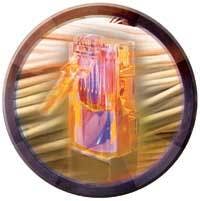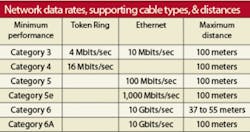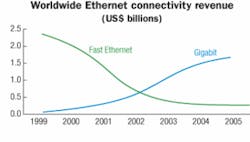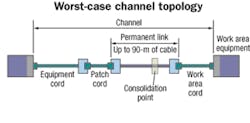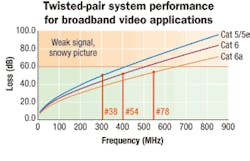With networking speeds escalating so quickly, it is imperative to ensure the cables supporting the network are up to the task, today, and for years to come.
One of the hot topics in the industry today is determining what type of cabling should be installed to meet data networking needs for the foreseeable future. The next generation of Ethernet will deliver a networking speed of up to 10 Gbits/sec (10GBase-T) over twisted-pair copper, which is 1,000 times faster than the original IEEE 802.3 10Base-T standard over Category 3 cabling (introduced in the early 1990s). Since then, the cabling performance standards published by both TIA and ISO have evolved from Category 3 to Category 5, 5e, 6, and most recently, 6A (Augmented Category 6).
With a number of restrictions, Category 6 is the minimum cabling performance required to support 10GBase-T. This article will examine the differences between Category 5e, 6, and 6A cabling types from a design, performance, and installation perspective. The goal is to help installers and end users make informed choices about which type of cabling is best suited to meet current and future application requirements.
What are the issues and limitations of Category 6 cabling for 10GBase-T, such as cabling distance, bundling and testing requirements? What are the different technologies and what are some of the issues that must be considered for Category 6A cabling? (A Category 6A cabling infrastructure is somewhat different from other cabling systems and components because it is specifically designed to drastically reduce alien crosstalk coupling between cabling in close proximity, and to extend the usable bandwidth up to 500 MHz and beyond.)
The historical evolution of cabling networks shows that network speeds increase by a factor of ten approximately every five years. Cabling performance has evolved to keep up with these data rates.
These are some of the important topics currently being discussed in the TIA standards committees.
Cabling evolution
The first structured cabling standard, EIA/TIA-568, was published in 1991. It recognized the installed base inside wiring cables at the time. These cables were characterized for transmission performance, and were designated as Category 3, intended primarily for low-frequency applications. The 10Base-T Ethernet standard was published around the same time and was designed to operate over Category 3 cabling for distances of up to 100 meters.
Approximately every five years, the network speed increases by a factor of ten, and cabling performance has evolved to support these higher data rates. The minimum performance level and the maximum supported distance for different network speeds are shown in the table, “Network data rates, supporting cable types, and distances.”
It is important to note that each of the higher categories are backward-compatible and interoperable with the lower-performance categories. The end-to-end channel performance is limited by the performance of the lowest category component in a channel, such as a patch cord, connector, or a length of cable. A worst-case channel topology can include up to four connectors.
Factors to consider
Factors you will need to consider when selecting the right kind of network cabling include price, performance, reliability, infrastructure, support for current and future applications, and cable management in terms of space and flexibility.
The higher category of performance provides more available bandwidth and a higher data-rate capability. The available bandwidth is determined by the cabling performance and the networking protocol.
10GBase-T transmission uses digital signal processing (DSP) technology to cancel out some of the internal noise due to near-end crosstalk and far-end crosstalk between pairs in a channel. As a result, the 500-MHz available bandwidth for Category 6A cabling is mainly limited by the external noise or alien crosstalk between cables in a bundle.
Also, Category 6A cabling has lower insertion loss, which translates into a stronger signal at higher frequencies. This means that for the broadband video application, it can support more cable TV channels for a distance of 100 meters. Lesser-performing cables would support fewer channels, or would need to be limited to some distance less than 100 meters.
Another factor to consider is that higher-performance cabling provides better noise immunity. Annex C of the TIA-569B standard provides a summary of noise-immunity tests that were performed for 1000Base-T transmission over Category 5e and Category 6 cabling in close proximity to power cables. Noise was injected on the power cables using an electrical fast transient (EFT) burst generator, per IEC 61000-4-4. For these tests, Category 6 channels provided twice the noise immunity-or, half the noise-of Category 5e channels. It is anticipated that Category 6A would provide a noise reduction factor of 0.3, or 70% less noise than Category 5e, because Category 6A cables are more tightly twisted and have better pair-balance characteristics.
In a worst-case four-connector channel like this one, even one component (cable, connector, or patch cord) rated at a lower category than the rest of the channel will bring the entire systems's performance down to the lowest category.
The pricing comparison shown in the table, “Comparison of categories 5e, 6, and 6A,” is based on the installed cost per drop for a plenum cable installation, including materials and labor to pull and terminate the cables. Labor rates are based on a large installation of more than 500 drops in a metropolitan area.
Finally, an important consideration is pathway sizing. Category 6A cables are larger in diameter than Category 6 and Category 5e, and so require more space. As indicated in the “Comparison of categories” table, a rough estimate suggests a tray measuring 24 inches wide and four inches deep can accommodate 1,400 Category 5e cables, 1,000 Category 6 cables,or 700 Category 6A cables.
Because of their comparatively larger size, Category 6A cables will require larger pathways to accommodate the same number of cables. The larger size, inherent in the cable design changes required to reduce alien crosstalk between cables, is to achieve the required signal-to-noise level for 10-Gbit/sec transmission.
Shown here is the worst-case channel insertion loss, including balun losses, for Category 5/5e, 6, and 6A systems intended to support broadband video applications. A Category 6A system will support the most cable TV channels in such a setup.
Category 6A cables are designed to meet stringent alien crosstalk requirements under worst-case bundling conditions. The TIA standard under development for Augmented Category 6 cabling specifies a 6-around-1 bundling configuration for testing, where the cables are parallel over the entire length of 90 meters and tie-wrapped every eight inches. This is far more severe than typical conditions in actual practice.
Category 6 cables were not specifically designed for optimum alien crosstalk performance between cables. Performance can vary depending on the cable design and installation conditions. Test results presented to the TIA TR-42.7 subcommittee indicate that alien near-end crosstalk tends to be dominated by the connectivity, and alien far-end crosstalk tends to be dominated by the cables. Maximum supported distances can vary from 37- to 55-meter channel distance, or possibly longer using mitigation techniques. The effectiveness of the mitigation techniques will depend on the nature of the alien crosstalk coupling.
It is possible to mitigate for alien near-end crosstalk by changing out the patch cords to Category 6A, or by using non-adjacent connectors on a patch panel, or ultimately to change out the connectivity to Category 6A. If the dominant interference source is alien far-end crosstalk, it is likely due to tight bundling conditions. An example might be cables that are suspended vertically and held in place using Kellems grips (wire mesh baskets). These grips tend to compress the cables tightly and significantly increase alien crosstalk coupling.
Long-term commitment
The active lifetime of network cabling is 7 to 12 years, so it is critical to ensure that the cabling installed today will support networking applications for the next decade, which may represent two more generations of network speed increases.
As it stands now, from a performance point of view, Category 5e is already outdated for the next-generation 10GBase-T network, and Category 6 is significantly limited in capability. That is why, taking into account all of the selection factors, it makes good business sense to consider Category 6A. Focus on Category 6A cablingNow that the standard for 10-Gbit Ethernet over high-performance Augmented Category 6A twisted-pair copper has been ratified, installers and end users are showing interest in what this means for their network infrastructure, both now and into the future.It was expected that the initial demand for Category 6A would be strong for data centers, which have a high density of computing devices. And that is indeed the case. Surprisingly, however, there is also great interest among end users and installers in exploring the value of Category 6A to the desktop to support increased network traffic and sophisticated applications, such as CAD/CAM, digital animation, multimedia, high-density storage, videoconferencing, and workflow collaboration.Despite the higher cost associated with Category 6A cabling systems compared to Category 5e and Category 6, larger enterprises are finding (through cost/benefit analyses over the expected life of the network) that implementation of Category 6A is well worth it to ensure that the network infrastructure will be capable of supporting current and future high-bandwidth applications, without costly upgrades and retrofits.Engineered for high performanceChannel performance is what matters most in 10-Gbit systems. A 10-Gbit system should be designed and engineered to fully comply with the forthcoming TIA-568B.2-10 Augmented Category 6 standard. This will allow for optimal performance even under worst-case installation conditions, such as cable bundling, which can cause electromagnetic coupling that exerts a negative impact on alien crosstalk performance.The key to superior channel performance is to ensure that all of the network system components-modules, patch cords, cables, and connectivity devices-are in tune with each other. Design and engineering features for a reliable Category 6A cabling system should include:• Modular jacks designed for extended high-frequency performance and very low alien crosstalk when inserted side-by-side in faceplates or patch panels;• Flexible patch cords designed to provide the highest level of crosstalk isolation caused by their close proximity to strong signals near electronic equipment;• Horizontal cables engineered for crosstalk isolation when installed in trays or conduit, or bundled together in racks or cabinets.Evaluating 10-Gbit systemsIn anticipation of the new performance standards, major cabling manufacturers have already introduced systems designed to support 10-Gigabit Ethernet over twisted-pair copper cables. Questions to consider when selecting a Category 6A structured cabling system include:• Does the system deal effectively with 10-Gbit transmission challenges, such as alien near-end crosstalk and alien far-end crosstalk, and provide stable transmission up to 500 MHz and beyond?• Can the manufacturer offer independent, third-party test results to back up their product performance claims?• Does the cable manufacturer offer certified installation through a network of partners, and do the manufacturer and installer stand behind the installation with extended performance guarantees and product and labor warranties? -PKPAUL KISH is director, Belden IBDN Systems and Standards, for Belden (www.belden.com). This year, he received the Harry J. Pfister Award for Excellence in the Telecommunications Industry, a “lifetime achievement award” given annually by BICSI.